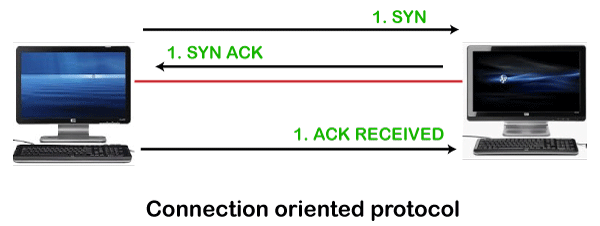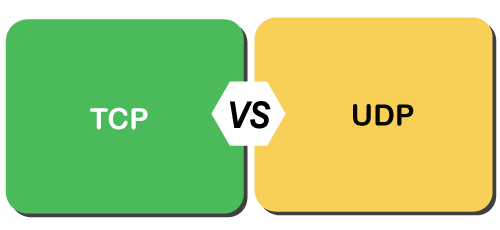Tutorial
Physical Layer
Data Link layer
Network Layer
Routing Algorithm
Transport Layer
Application Layer
Network Security
Misc
- Router
- OSI vs TCP/IP
- TCP vs UDP
- Transmission Control Protocol
- TCP port
- IPv4 vs IPv6
- ARP Packet Format
- ARP Table
- Working of ARP
- FTP Client
- FTP Commands
- FTP Server
- I2C Protocol
- Sliding Window Protocol
- SPI Protocol
- IP
- ARP Commands
- ARP
- Address Resolution Protocol
- ARP and its types
- TCP Retransmission
- CAN protocol
- HTTP Status Codes
- HTTP vs HTTPS
- RIP Protocol
- UDP Protocol
- ICMP Protocol
- MQTT protocol
- OSPF Protocol
- Stop and Wait Protocol
- IMAP Protocol
- POP Protocol
- CIFS
- DAS
- DIMM
- iSCSI
- NAS (Network Attached Storage)
- NFS
- NVMe
- SAN
- Border Gateway Protocol
- Go-Back-N ARQ
- RJ Cable
- Difference between Connection-Oriented and Connectionless Service
- CDMA vs. GSM
- What is MAC Address
- Modem vs. Router
- Switch Vs. Router
- USB 2.0 vs 3.0
- Difference between CSMA CA and CSMA CD
- Multiple access protocol- ALOHA, CSMA, CSMA/CA and CSMA/CD
- URI vs URL
- IMAP vs. POP3
- SSH Meaning| SSH Protocol
- UTP vs STP
- Status Code 400
- MIME Protocol
- IP address
- proxy server
- How to set up and use a proxy server
- network security
- WWW is based on which model
- Proxy Server List
- Fundamentals of Computer Networking
- IP Address Format and Table
- Bus topology and Ring topology
- Bus topology and Star topology
- Circuit Switching and Packet switching?
- Difference between star and ring topology
- Difference between Router and Bridge
- TCP Connection Termination
- Image Steganography
- Network Neutrality
- Onion Routing
- Adaptive security appliance (ASA) features
- Relabel-to-front Algorithm
- Types of Server Virtualization in Computer Network
- Access Lists (ACL)
- What is a proxy server and how does it work
- Digital Subscriber Line (DSL)
- Operating system based Virtualization
- Context based Access Control (CBAC)
- Cristian's Algorithm
- Service Set Identifier (SSID)
- Voice over Internet Protocol (VoIP)
- Challenge Response Authentication Mechanism (CRAM)
- Extended Access List
- Li-fi vs. Wi-fi
- Reflexive Access List
- Synchronous Optical Network (SONET)
- Wifi protected access (WPA)
- Wifi Protected Setup (WPS)
- Standard Access List
- Time Access List
- What is 3D Internet
- 4G Mobile Communication Technology
- Types of Wireless Transmission Media
- Best Computer Networking Courses
- Data Representation
- Network Criteria
- Classful vs Classless addressing
- Difference between BOOTP and RARP in Computer Networking
- What is AGP (Accelerated Graphics Port)
- Advantages and Disadvantages of Satellite Communication
- External IP Address
- Asynchronous Transfer Mode (ATM)
- Types of Authentication Protocols
- What is a CISCO Packet Tracer
- BOOTP work
- Subnetting in Computer Networks
- Mesh Topology Advantages and Disadvantages
- Ring Topology Advantages and Disadvantages
- Star Topology Advantages and Disadvantages
- Tree Topology Advantages and Disadvantages
- Zigbee Technology-The smart home protocol
- Network Layer in OSI Model
- Physical Layer in OSI Model
- Data Link Layer in OSI Model
- Internet explorer shortcut keys
- Network Layer Security | SSL Protocols
- Presentation Layer in OSI Model
- Session Layer in OSI Model
- SUBNET MASK
- Transport Layer Security | Secure Socket Layer (SSL) and SSL Architecture
- Functions, Advantages and Disadvantages of Network Layer
- Protocols in Noiseless and Noisy Channel
- Advantages and Disadvantages of Mesh Topology
- Cloud Networking - Managing and Optimizing Cloud-Based Networks
- Collision Domain and Broadcast Domain
- Count to Infinity Problem in Distance Vector Routing
- Difference Between Go-Back-N and Selective Repeat Protocol
- Difference between Stop and Wait, GoBackN, and Selective Repeat
- Network Function Virtualization (NFV): transforming Network Architecture with Virtualized Functions
- Network-Layer Security | IPSec Modes
- Next - Prev Network-Layer Security | IPSec Protocols and Services
- Ping vs Traceroute
- Software Defined Networking (SDN): Benefits and Challenges of Network Virtualization
- Software Defined Networking (SDN) vs. Network Function Virtualization (NFV)
- Virtual Circuits vs Datagram Networks
- BlueSmack Attack in Wireless Networks
- Bluesnarfing Attack in Wireless Networks
- Direct Sequence Spread Spectrum
- Warchalking in Wireless Networks
- WEP (Wired Equivalent Privacy)
- Wireless security encryption
- Wireless Security in an Enterprise
- Quantum Networking
- Network Automation
- Difference between MSS and MTU
- What is MTU
- Mesh Networks: A decentralized and Self-Organizing Approach to Networking
- What is Autonomous System
- What is MSS
- Cyber security & Software security
- Information security & Network security.
- Security Engineer & Security Architect
- Protection Methods for Network Security
- Trusted Systems in Network Security
- What are Authentication Tokens in Network security
- Cookies in Network Security
- Intruders in Network Security
- Network Security Toolkit (NST) in virtual box
- Pivoting-Moving Inside a Network
- Security Environment in Computer Networks
- Voice Biometric technique in Network Security
- Advantages and Disadvantages of Conventional Testing
- Difference between Kerberos and LDAP
- Cyber security and Information Security
- GraphQL Attacks and Security
- Application Layer in OSI Model
- Applications of Remote Sensing
- Seven Layers of IT Security
- What is Ad Hoc TCP
- What is Server Name Indication(SNI)
TCP vs UDP
What is the TCP?
The TCP stands for Transmission Control Protocol. If we want the communication between two computers and communication should be good and reliable. For example, we want to view a web page, then we expect that nothing should be missing on the page, or we want to download a file, then we require a complete file, i.e., nothing should be missing either it could be a text or an image. This can only be possible due to the TCP. It is one of the most widely used protocols over the TCP/IP network.
Features of TCP
The following are the features of the TCP:
- Data delivery
TCP protocol ensures that the data is received correctly, no data is missing and in order. If TCP protocol is not used, then the incorrect data can be received or out of order. For example, if we try to view the web page or download a file without using TCP, then some data or images could be missing. - Protocol
TCP is a connection-oriented protocol. Through the word connection-oriented, we understand that the computers first establish a connection and then do the communication. This is done by using a three-way handshake. In a three-way handshake, the first sender sends the SYN message to the receiver then the receiver sends back the SYN ACK message to confirm that the message has been received. After receiving the SYN ACK message, the sender sends the acknowledgment message to the receiver. In this way, the connection is established between the computers. Once the connection is established, the data will be delivered. This protocol guarantees the data delivery means that if the data is not received then the TCP will resend the data.

What is UDP?
The UDP stands for User Datagram Protocol. Its working is similar to the TCP as it is also used for sending and receiving the message. The main difference is that UDP is a connectionless protocol. Here, connectionless means that no connection establishes prior to communication. It also does not guarantee the delivery of data packets. It does not even care whether the data has been received on the receiver's end or not, so it is also known as the "fire-and-forget" protocol. It is also known as the "fire-and-forget" protocol as it sends the data and does not care whether the data is received or not. UDP is faster than TCP as it does not provide the assurance for the delivery of the packets.
Differences between the TCP and UDP

- Type of protocol
Both the protocols, i.e., TCP and UDP, are the transport layer protocol. TCP is a connection-oriented protocol, whereas UDP is a connectionless protocol. It means that TCP requires connection prior to the communication, but the UDP does not require any connection. - Reliability
TCP is a reliable protocol as it provides assurance for the delivery of the data. It follows the acknowledgment mechanism. In this mechanism, the sender receives the acknowledgment from the receiver and checks whether the acknowledgment is positive or negative. If the ACK is positive means, the data has been received successfully. If ACK is negative, then TCP will resend the data. It also follows the flow and error control mechanism.
UDP is an unreliable protocol as it does not ensure the delivery of the data. - Flow Control
TCP follows the flow control mechanism that ensures a large number of packets are not sent to the receiver at the same time, while UDP does not follow the flow control mechanism. - Ordering
TCP uses ordering and sequencing techniques to ensure that the data packets are received in the same order in which they are sent. On the other hand, UDP does not follow any ordering and sequencing technique; i.e., data can be sent in any sequence. - Speed
Since TCP establishes a connection between a sender and receiver, performs error checking, and also guarantees the delivery of data packets while UDP neither creates a connection nor it guarantees the delivery of data packets, so UDP is faster than TCP. - Flow of data
In TCP, data can flow in both directions means that it provides the full-duplex service. On the other hand, UDP is mainly suitable for the unidirectional flow of data.
Let's look at the differences between the TCP and UDP in a tabular form.
| TCP | UDP | |
|---|---|---|
| Full form | It stands for Transmission Control Protocol. | It stands for User Datagram Protocol. |
| Type of connection | It is a connection-oriented protocol, which means that the connection needs to be established before the data is transmitted over the network. | It is a connectionless protocol, which means that it sends the data without checking whether the system is ready to receive or not. |
| Reliable | TCP is a reliable protocol as it provides assurance for the delivery of data packets. | UDP is an unreliable protocol as it does not take the guarantee for the delivery of packets. |
| Speed | TCP is slower than UDP as it performs error checking, flow control, and provides assurance for the delivery of | UDP is faster than TCP as it does not guarantee the delivery of data packets. |
| Header size | The size of TCP is 20 bytes. | The size of the UDP is 8 bytes. |
| Acknowledgment | TCP uses the three-way-handshake concept. In this concept, if the sender receives the ACK, then the sender will send the data. TCP also has the ability to resend the lost data. | UDP does not wait for any acknowledgment; it just sends the data. |
| Flow control mechanism | It follows the flow control mechanism in which too many packets cannot be sent to the receiver at the same time. | This protocol follows no such mechanism. |
| Error checking | TCP performs error checking by using a checksum. When the data is corrected, then the data is retransmitted to the receiver. | It does not perform any error checking, and also does not resend the lost data packets. |
| Applications | This protocol is mainly used where a secure and reliable communication process is required, like military services, web browsing, and e-mail. | This protocol is used where fast communication is required and does not care about the reliability like VoIP, game streaming, video and music streaming, etc. |


